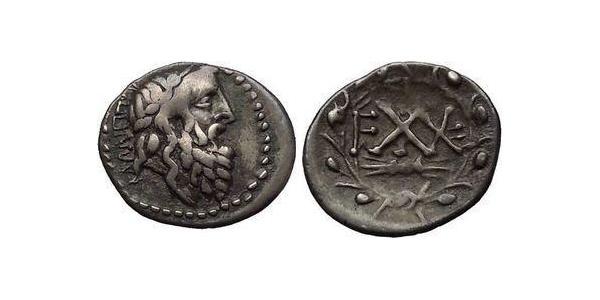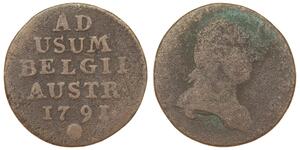[ 5758] ELIS. OLYMPIA. Silver Hemidrachm (18mm, 2.12 gm,). Achaian League, 50-30 B.C. References: BCD 690. Head of Zeus left. Monogram. A fertile country in the north-west of the Peloponnese, Elis possessed the famous festival center of Olympia where the Greeks celebrated the Olympic Games every four years. The coinage in the name of the Eleans was issued not from the city of Elis itself, but from the festival center, in connection with each Olympic gathering. Provided with certificate of authenticity. CERTIFIED AUTHENTIC by Sergey Nechayev, PhD - Numismatic Expert Olympia (Greek: Ολυμπία Olympí'a, older transliterations, Olimpia, Olimbia), a sanctuary of ancient Greece in Elis, is known for having been the site of the Olympic Games in classical times, comparable in importance to the Pythian Games held in Delphi. Both games were held every Olympiad (i.e. every four years), the Olympic Games dating back possibly further than 776 BC. In 394 AD ( after exactly 1170 years ) emperor Theodosius I abolished them as they were then considered reminiscent of paganism. The first olympic games were in Olympia in honor of Zeus. The sanctuary, known as the Altis, consists of an unordered arrangement of various buildings. Enclosed within the temenos (sacred enclosure) are the Temple of Hera (or Heraion/Heraeum) and Temple of Zeus, the Pelopion and the area of the altar, where the sacrifices were made. The hippodrome and later stadium were also to the east. To the north of the sanctuary can be found the Prytaneion and the Philippeion, as well as the array of treasuries representing the various city states. The Metroon lies to the south of these treasuries, with the Echo Stoa to the East. To the south of the sanctuary is the South Stoa and the Bouleuterion, whereas the West side houses the Palaestra, the workshop of Pheidias, the Gymnasion and the Leonidaion. Olympia is also known for the gigantic ivory and gold statue of Zeus that used to stand there, sculpted by Pheidias, which was named one of the Seven Wonders of the Ancient World by Antipater of Sidon. Very close to the Temple of Zeus which housed this statue, the studio of Pheidias was excavated in the 1950s. Evidence found there, such as sculptor's tools, corroborates this opinion. The ancient ruins sit north of the Alfeios River and Mount Kronos (named after the Greek deity Kronos). The Kladeos, a tributary of the Alfeios, flows around the area. Its located in the part of Greece which is called Peloponesse. In ancient greece Olympia was sacred ground to the greeks. Payment & Shipping: Will accept payments via PayPal. = MM_contentVersion;
}
else if (navigator.userAgent && navigator.userAgent.indexOf("MSIE")>=0 && (navigator.appVersion.indexOf("Win") != -1)) {
document.write('\n');
document.write('on error resume next\n');
document.write('MM_FlashCanPlay = ( IsObject(CreateObject("ShockwaveFlash.ShockwaveFlash." & MM_contentVersion)))\n\n');
}
if (MM_FlashCanPlay) {
document.write('');
document.write(' ');
document.write(' ');
document.write(' ');
document.write(' ');
document.write(' ');
document.write(' ');
document.write(' ');
document.write(' ');
document.write(' ');
document.write(' ');
}
else {
document.write(' ');
document.write(' ');
document.write(' This Vendio Gallery is best viewed with Macromedia Flash Player 6or higher. ');
document.write(' Click here to get the latestMacromedia Flash Player. ');
document.write(' ');
document.write(' ');
document.write(' ');
}
//--> Your browser does not support JavaScript. To view this page, enable JavaScript if it is disabled or upgrade your browser.
más ...
Similar Coin Groups

8 Maravedi Kingdom of Spain (1814 - 1873 ...
grupo tiene 6 monedas / 6 precios
Add coin to this group

1 Thaler Reino de Sajonia (1806 - 1918) ...
grupo tiene 13 monedas / 13 precios
Add coin to this group
2025-05-25
- New coin is added to 1 Liard Países Bajos Austríacos (1713-1795) Cobre
1 Liard Países Bajos Austríacos (1713-1795) Cobre
grupo tiene 7 monedas / 7 precios
⇑
Austrian Netherlands - Liard 1791 - Head
2025-05-23
-
Monedas nuevas
Monedas nuevas de
Save seller - lne.inc
.
Una de ellas es
Una de ellas es
Germany Bavaria 1778 H.ST - Silver Thaler - KM# 562 - DAV# 1963
Usted podría estar interesado en …













-300-150-NgSsHgTyCiIAAAGW1HxyjNgw.jpg)







